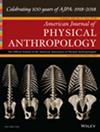尼安德特人骨骼迷宫重新考虑,引入一种新的几何形态测量方法
IF 2.6
2区 地球科学
Q1 ANTHROPOLOGY
引用次数: 8
摘要
在坦桑尼亚的哈兹达狩猎采集者中,孩子们是活跃的觅食者,收集各种野生植物食物,捕猎小型猎物。据报道,哈兹达儿童的采集努力对母亲的觅食产量有积极影响(bulburton - jones et at。1994,人类学研究50(3):217;Hawkes et al. 1995, Current Anthropology 36(4): 688),然而,关于儿童食物的热量值以及儿童分配自己的觅食量的方式的定量数据很少。在这里,我们报告了几种由儿童收集的植物性食物的觅食回报率、消费数据和成分值。由于捕食者的压力,儿童在没有成人监督的情况下远离营地是不安全的,因此他们通常会关注离营地近且易于收集和加工的食物。我们计算了以下食物的热量含量:猴面包树果实(346千卡/100g干物质)、浆果(320千卡/100g干物质)、豆类(311千卡/100g干物质)、核果(325千卡/100g干物质)和无花果(365千卡/100g干物质)。豆类、核果和无花果以前没有被分析过;我们对猴面包树和浆果的价值与之前的分析一致(Murray et al. 2001, Journal of Food Consumption and Analysis, 14:3)。此外,我们计算了儿童的觅食回报率和每日消费价值。我们的研究结果表明,他们收集了他们每天热量摄入的很大一部分,并作为其他孩子提供热量的来源。支持:美国国家科学基金会、加州大学圣地亚哥分校董事会、加州大学圣地亚哥分校国际中心之友和哈佛大学。本文章由计算机程序翻译,如有差异,请以英文原文为准。
The Neanderthal bony Labyrinth Reconsidered, Introducing a New Geometric Morphometric Approach
The widely accepted socio-ecological model of primate sociality assumes that males and female chimpanzees do not exhibit differentiated social relationships. However, despite anecdotal evidence to the contrary, this assumption has never been explicitly tested. We used 14 years of data from the Kanyawara community in Kibale National Park, Uganda to describe inter-sexual association patterns among these chimpanzees. We calculated a composite index using temporal and spatial association data to characterize the relationships between data to characterize the relationships between 336 male-females dyads. We considered any dyad with a composite index greater than one standard deviation above the mean to be strongly associated. We found that: (1) while the majority of male-female dyads were not strongly associated, a subset of dyads showed greater than average association across several two-year time periods; (2) all but one of the maternal kin dyads (either mother-son or brother-sister) had differentiated relationships; and (3) the association preferences of some dyads remained consistent despite changes in the reproductive condition of the female over time. We used generalized linear models to determine the effect of reproductive state, rank and seasonality on patterning these longterm associations. Our finding that chimpanzees exhibit differentiated inter-sexual association patterns will have far-reaching effects on studies of other forms of malefemale interaction such as aggression, and further our understanding of the evolution of human pair-bonding.
求助全文
通过发布文献求助,成功后即可免费获取论文全文。
去求助
来源期刊
CiteScore
4.80
自引率
0.00%
发文量
3
审稿时长
3-8 weeks
期刊介绍:
The American Journal of Physical Anthropology (AJPA) is the official journal of the American Association of Physical Anthropologists. The Journal is published monthly in three quarterly volumes. In addition, two supplements appear on an annual basis, the Yearbook of Physical Anthropology, which publishes major review articles, and the Annual Meeting Issue, containing the Scientific Program of the Annual Meeting of the American Association of Physical Anthropologists and abstracts of posters and podium presentations. The Yearbook of Physical Anthropology has its own editor, appointed by the Association, and is handled independently of the AJPA. As measured by impact factor, the AJPA is among the top journals listed in the anthropology category by the Social Science Citation Index. The reputation of the AJPA as the leading publication in physical anthropology is built on its century-long record of publishing high quality scientific articles in a wide range of topics.

 求助内容:
求助内容: 应助结果提醒方式:
应助结果提醒方式:


